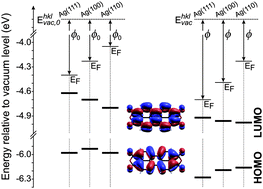The interplay between interface structure, energy level alignment and chemical bonding strength at organic–metal interfaces
Abstract
What do energy level alignments at metal–organic interfaces reveal about the metal–molecule bonding strength? Is it permissible to take vertical adsorption heights as indicators of bonding strengths? In this paper we analyse 3,4,9,10-perylene-tetracarboxylic acid dianhydride (PTCDA) on the three canonical low index Ag surfaces to provide exemplary answers to these questions. Specifically, we employ angular resolved photoemission spectroscopy for a systematic study of the energy level alignments of the two uppermost frontier states in ordered monolayer phases of PTCDA. Data are analysed using the orbital tomography approach. This allows the unambiguous identification of the orbital character of these states, and also the discrimination between inequivalent species. Combining this experimental information with DFT calculations and the generic Newns–Anderson chemisorption model, we analyse the alignments of highest occupied and lowest unoccupied molecular orbitals (HOMO and LUMO) with respect to the vacuum levels of bare and molecule-covered surfaces. This reveals clear differences between the two frontier states. In particular, on all surfaces the LUMO is subject to considerable bond stabilization through the interaction between the molecular π-electron system and the metal, as a consequence of which it also becomes occupied. Moreover, we observe a larger bond stabilization for the more open surfaces. Most importantly, our analysis shows that both the orbital binding energies of the LUMO and the overall adsorption heights of the molecule are linked to the strength of the chemical interaction between the molecular π-electron system and the metal, in the sense that stronger bonding leads to shorter adsorption heights and larger orbital binding energies.


 Please wait while we load your content...
Please wait while we load your content...